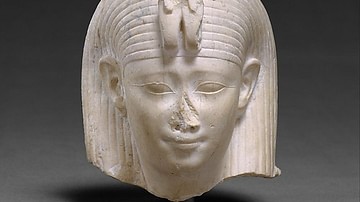
Arsinoë IV (d. 41 BCE) was a Ptolemaic princess who rebelled against her sister Cleopatra VII during the Alexandrian War in 48 BCE. After being defeated by Cleopatra's ally Julius Caesar, she was a captive in his Roman triumph. Arsinoë later became a priestess at the Temple of Artemis at Ephesus until Mark Antony and Cleopatra had her assassinated.
Early Life & Background
Arsinoë was the daughter of Ptolemy XII Auletes (r. 80-51 BCE), king of Ptolemaic Egypt. She had two sisters, Berenike IV (r. 58-55 BCE) and Cleopatra VII (l. 70/69-30 BCE), and two brothers, Ptolemy XIII (l. 62/61-47 BCE) and Ptolemy XIV (l. 60/59-44 BCE). Her exact age is not mentioned by ancient sources, but she was younger than her sisters and older than her brothers. By the time Arsinoë was born, Ptolemy XII's wife Cleopatra V Tryphaena had disappeared from Egyptian inscriptions. It is unknown whether this is because Cleopatra Tryphaena died or because they divorced. Arsinoë's mother was an unknown wife or concubine of the king.
Arsinoë was probably born in the capital city Alexandria. Because she was not in line for the crown, contemporary writers paid little attention to her, and nothing is known of her childhood. Like all women in the Ptolemaic dynasty, she would have received an education in areas like politics and Greek philosophy. Her tutor was a eunuch named Ganymedes, who also acted as her legal guardian. She would also have been expected to become proficient in horseback riding.
In 58 BCE, Berenike IV usurped the throne of Ptolemy XII and declared herself queen. Cleopatra and Arsinoë are thought to have accompanied their father when he went into exile. Searching for an army capable of restoring his throne, Ptolemy XII went to Rome where he had made allies by bribing politicians like Julius Caesar and Pompey the Great. Pompey instructed his general Aulus Gabinius to help Ptolemy XII reconquer Egypt in 56 BCE. The victorious king had Berenike executed and made Cleopatra VII his co-ruler.
Cleopatra's Usurpation & Exile
Ptolemy XII died in 51 BCE, naming the 18-year-old Cleopatra VII and 10-year-old Ptolemy XIII as his heirs. Since Ptolemy XIII was a child, political decisions were made in his name by his tutor Theodotus, the minister Pothinus, and the general Achillas. From the beginning, these advisors disagreed with Cleopatra VII, leading to a feud between the young king and queen. By the end of 49 BCE, Cleopatra had been driven out of the capital by a coup and forced to retreat to Thebes.
The first direct references to Arsinoë in Roman accounts describe how she accompanied Cleopatra in exile. It is not known whether Arsinoë went willingly to support her sister, or whether she was taken as a hostage. Cleopatra and Arsinoë traveled to Syria to gather an army. After raising her army, Cleopatra returned to Egypt and prepared to fight Ptolemy XIII's army at the border fortress in Pelusium.
At the same time, Pompey the Great fled to Egypt after being defeated in a civil war against his co-consul Caesar. Pompey's sudden arrival paused the conflict between Cleopatra and Ptolemy XIII, who rushed to meet him. Caesar was expected to arrive soon in pursuit of Pompey. Ptolemy XIII's advisers convinced him to kill Pompey and give his severed head to Caesar. This angered Caesar, who stayed in Egypt to arbitrate the succession himself.
Caesar also demanded the money promised to him by the late Ptolemy XII, claiming that he was owed 17.5 million drachmas, equal to the entire country's annual revenue. Ptolemy XIII's advisors struggled to deliver the money demanded by Caesar, allegedly resorting to melting down the palace's gold and silverware.
Alexandrian War
In Pelusium, Cleopatra planned to turn Caesar against Ptolemy XIII, hoping that he would see her as a more reliable and experienced ally than her brother. She smuggled herself into Alexandria and became Caesar's lover. He declared that Ptolemy XIII and Cleopatra VII should marry and rule together, according to their father's will. During the temporary armistice, Arsinoë rejoined her siblings in the palace. Caesar had only a weak legal basis for dictating the Egyptian succession and only a single legion or the Roman army to defend him. As leverage, he kept all potential heirs, including Arsinoë, in the palace under armed guard.
In late 48 BCE, an anti-Roman riot broke out in Alexandria, forcing Caesar to calm the populace with reassurances. He agreed to return the island of Cyprus, which had been annexed by Rome years prior. Arsinoë and her youngest brother Ptolemy XIV were named co-rulers of Cyprus, although they were not yet allowed to travel to their new kingdom. Soon after, Achillas arrived in Alexandria with the Egyptian army and attacked the Romans. In the confusion, Arsinoë and Ganymedes escaped together.
Arsinoe, acting through the eunuch Ganymedes, her tutor, struck the first blow and killed Achillas. After his murder she herself exercised complete control without any consort or guardian, while the army was entrusted to Ganymedes.
(Julius Caesar, Di Bello Alexandrini, 4, trans. Way)
The army proclaimed her queen, since Ptolemy XIII was in the custody of Caesar. Ganymedes and Achillas competed to win the loyalty of the Egyptian army through gifts and increased pay. Arsinoë executed Achillas, allowing Ganymedes to focus on the war. He trapped Caesar's forces in the royal quarter and laid siege to them, building roadblocks and fortifications in the city streets. At one point, he even cut off Caesar's access to fresh water.
Caesar released Ptolemy XIII from captivity, hoping to buy himself time by creating chaos in the Egyptian army. The Egyptian soldiers imprisoned Arsinoë and Ganymedes and rallied around Ptolemy XIII. Caesar received reinforcements sent by the allied kingdoms of Pergamum and Judea, allowing him to defeat the Egyptians at the Battle of the Nile in the summer of 47 BCE. Ptolemy XIII died in the battle, and Cleopatra became sole ruler. After the war was settled, Caesar took Arsinoë away as his prisoner.
Julius Caesar's Triumph
Caesar brought Arsinoë back to Rome, where she was imprisoned alongside other rulers taken captive by him during his conquests. These included Vercingetorix of Gaul and Juba II of Numidia. It was traditional for captive kings and generals to be marched through the streets during a Roman triumph, a victory parade celebrating great conquests. Many rulers committed suicide to avoid being mistreated and publicly humiliated by their captors during a triumph. Women were not usually led in triumph as captive rulers, but Caesar made an exception for Arsinoë.
In 46 BCE, Caesar celebrated a quadruple triumph to commemorate his conquest of Gaul, Egypt, Pontus, and Africa. Captives, treasures, and artworks looted by Caesar's army were paraded through the city. During the Egyptian triumph on the second day, Arsinoë was marched through the streets in golden chains so that the Roman mob could witness her ordeal. Roman accounts describe her as a dignified, sympathetic figure who moved the spectators to pity.
Ganymedes was executed after the triumph, but Caesar declared that Arsinoë would be spared as a favor to her remaining siblings. Arsinoë's life was probably saved by the outpouring of public support and Caesar's desire to appear merciful. Her cruel treatment at the triumph symbolized Egypt's subjugation by the Roman Republic and humiliated the Ptolemaic dynasty. It also contributed to negative perceptions of Caesar as a tyrant. Cleopatra was visiting Rome around this time, but her reaction to these events is not known.
Exile & Assassination
After the triumph, Arsinoë was allowed to join the priestesses of the Temple of Artemis at Ephesus. Holding a priestly office was meant to prevent her from laying claim to the Egyptian throne. However, there were still many who believed that she should rule Egypt. The high priest Megabyzus even hailed her as queen, in clear defiance of Cleopatra.

In 43 BCE, the Roman Republic descended into civil war sparked by the assassination of Julius Caesar the year before. Cleopatra sided with Caesar's successors Octavian and Mark Antony against the assassins Cassius and Brutus. Serapion, the Egyptian governor of Cyprus, ignored her orders and began aiding Cassius. Modern historians have suggested that Serapion's betrayal was part of a plot to restore Arsinoë to the Egyptian throne with Cassius' support.
After Cassius was defeated at the Battle of Phillippi, Cleopatra took back control of Cyprus. She executed Serapion and other Egyptian naval commanders who had sided with him. In the aftermath of these events, Cleopatra began to view her remaining siblings as potential threats to herself and her son Caesarion (l. c. 47-30 BCE). She was suspected of poisoning her brother Ptolemy XIV, who died unexpectedly in 43 BCE. Next, she plotted against Arsinoë, who she feared might continue to challenge her reign.
In 41 BCE, Cleopatra convinced her ally and lover Mark Antony to arrange Arsinoë's murder. Antony's men murdered Arsinoë inside the temple, despite the fact that this was an affront to the gods. Megabyzus was also arrested, but he was spared after the Ephesians petitioned Cleopatra to show mercy.
Aftermath
Octavian defeated Cleopatra and Antony at the Battle of Actium in 30 BCE and established Roman Egypt. Cleopatra committed suicide to avoid being led in triumph as Arsinoë had been years earlier. While less famous than her sister, Arsinoë has been depicted in film and literature. Some depict Arsinoë as a vindictive traitor, while others view her more sympathetically as a victim of circumstance.
[Cleopatra], who had killed her brother with poison, made [Antony] kill her sister Arsinoe, in order to remove a threat to her power. The crime was committed in the Temple of Diana at Ephesus, where the unlucky girl had fled, seeking sanctuary. It was as if Cleopatra were receiving a sacrifice from her lover.
(Giovanni Boccaccio, On Famous Women)
The murder of Arsinoë is considered to be one of the most brutal acts of Cleopatra's reign. Writers like Flavius Josephus (36-100 CE) and Giovanni Boccaccio (1313-1375) have highlighted it as an example of her tyranny and immorality. However, many historians also emphasize that it was necessary to safeguard her reign and prevent future civil wars.
Possible Tomb in Ephesus
In 1926, archaeologists unearthed "The Octagon", a monumental tomb in the center of Ephesus. The octagonal tomb was originally surrounded by a marble colonnade with a circular canopy. It was covered by a stepped roof. The tomb is located within the city walls, at the end of the ancient processional street. Bodies were only buried within ancient cities on rare occasions, and this was an honor reserved for very important figures. The tomb was opened in 1929, and a skeleton was found inside. The skeleton was initially identified as a teenage girl, and its skull was taken to Germany where it was subjected to pseudoscientific ancestry tests.
Archaeologist Hilke Thür theorized that it was the tomb of Arsinoë because its unusual octagonal shape resembled the famous Lighthouse of Alexandria. Some scholars doubted this theory because the tomb did not strongly resemble a lighthouse, and there was not much evidence linking it to Arsinoë. In 2025, researchers from the University of Vienna subjected the skull to genetic analysis and physical examinations. They discovered that the skull actually belonged to a young boy with developmental disorders, finally disproving the identification with Arsinoë. The actual burial place of Arsinoë remains unknown.








